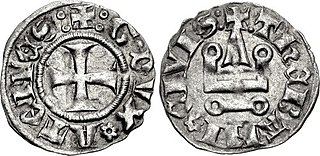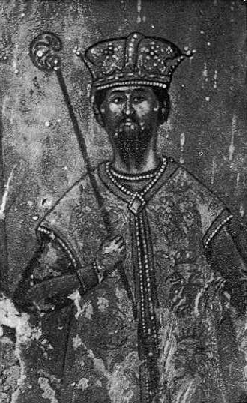
The Duchy of Athens was one of the Crusader states set up in Greece after the conquest of the Byzantine Empire during the Fourth Crusade as part of the process known as Frankokratia, encompassing the regions of Attica and Boeotia, and surviving until its conquest by the Ottoman Empire in the 15th century.

Walter V of Brienne was Duke of Athens from 1308 until his death. Being the only son of Hugh of Brienne and Isabella de la Roche, Walter was the heir to large estates in France, the Kingdom of Naples, and the Peloponnese. He was held in custody in the Sicilian castle of Augusta between 1287 and 1296 or 1297 to secure the payment of his father's ransom to the Aragonese admiral Roger of Lauria. When his father died fighting against Lauria in 1296, Walter inherited the County of Brienne in France, and the counties of Lecce and Conversano in southern Italy. He was released, but he was captured during a Neapolitan invasion of Sicily in 1299. His second captivity lasted until the Treaty of Caltabellotta in 1302.

The Battle of Halmyros, known by earlier scholars as the Battle of the Cephissus or Battle of Orchomenos, was fought on 15 March 1311, between the forces of the Frankish Duchy of Athens and its vassals under Walter of Brienne against the mercenaries of the Catalan Company, resulting in a decisive victory for the mercenaries.

The Duchy of Neopatras was a principality in southern Thessaly, established in 1319. Officially part of the Kingdom of Sicily, itself part of the Crown of Aragon, the duchy was governed in conjunction with the neighbouring Duchy of Athens, it enjoyed a large degree of self-government. From the mid-14th century, the duchies entered a period of decline: most of the Thessalian possessions were lost to the Serbian Empire, internal dissensions arose, along with the menace of Turkish piracy in the Aegean and the onset of Ottoman expansion in the Balkans. Enfeebled, the Catalan possessions were taken over by the Florentine adventurer Nerio I Acciaioli in 1385–1390. The title of Duke of Neopatras was held by the heir of the King of Sicily.
The Navarrese Company was a company of mercenaries, mostly from Navarre and Gascony, which fought in Albania and Greece during the late 14th century and early 15th century, in the twilight of Frankish power in the dwindling remnant of the Latin Empire. "Navarrese Company" is a modern informal term for these soldiers and is thus somewhat inaccurate.

Guy II de la Roche, also known as Guyot or Guidotto, was the Duke of Athens from 1287, the last duke of his family. He succeeded as a minor on the death of his father, William I, at a time when the duchy of Athens had exceeded the Principality of Achaea in wealth, power, and importance.

Nerio I Acciaioli or Acciajuoli was the de facto Duke of Athens from 1385 to 1388, after which he reigned uncontested until his death in 1394. Born to a family of Florentine bankers, he became the principal agent of his influential kinsman, Niccolò Acciaioli, in Frankish Greece in 1360. He purchased large domains in the Principality of Achaea and administered them independently of the absent princes. He hired mercenaries and conquered Megara, a strategically important fortress in the Duchy of Athens, in 1374 or 1375. His troops again invaded the duchy in 1385. The Catalans who remained loyal to King Peter IV of Aragon could only keep the Acropolis of Athens, but they were also forced into surrender in 1388.
Don Alfonso Fadrique was the eldest and illegitimate son of Frederick II of Sicily. He served as vicar general of the Duchy of Athens from 1317 to 1330.
The margraviate or marquisate of Bodonitsa, today Mendenitsa, Phthiotis, was a Frankish state in Greece following the conquests of the Fourth Crusade. It was originally granted as a margravial holding of Guy Pallavicini by Boniface, first king of Thessalonica, in 1204. Its original purpose was to guard the pass of Thermopylae.
Francis Zorzi (1337–1388), called Marchesotto, was a member of the Venetian Zorzi family and the Marquess of Bodonitsa in Central Greece from 1345 to his death.
Joanna of Châtillon or Joan, French: Jeanne; was the wife of Walter V of Brienne (1305). She was Duchess of Athens by marriage (1308–1311). She was the daughter of Gaucher V de Châtillon, Constable of France and Isabelle de Dreux. Her paternal grandparents were Gaucher IV de Châtillon and Isabelle de Villehardouin. Her maternal grandparents were Robert de Dreux, Viscount of Chateaudun and Isabelle de Villebéon.
Nicholas I Sanudo was the fifth Duke of the Archipelago from 1323 to his death. He was the son and successor of William I of the House of Sanudo.

Louis Fadrique a Catalan nobleman who was Count of Salona, as well as lord of various other towns in Central Greece from ca. 1365 until his death in 1382. In 1375–1381 he also served as the vicar-general of the twin duchy of Athens and Neopatras.
Juan de Urtubia was a Navarrese royal squire who led first a contingent of fifty men-at-arms on an expedition to recover the Kingdom of Albania (1376–1377) and later a large army against Thebes and Boeotia, which he conquered in 1379.

The Frankokratia, also known as Latinokratia and, for the Venetian domains, Venetokratia or Enetokratia, was the period in Greek history after the Fourth Crusade (1204), when a number of primarily French and Italian states were established by the Partitio terrarum imperii Romaniae on the territory of the dismantled Byzantine Empire.
Joanna of Durazzo was the eldest daughter and eldest surviving child of Charles, Duke of Durazzo, and his wife, Maria of Calabria. She succeeded as duchess on the death of her father in 1348 when she was only a child of four years old. Joanna was a member of the House of Anjou-Durazzo.

Skanderbeg's rebellion was an almost 25-year long anti-Ottoman rebellion led by the Albanian military commander Skanderbeg in what is today Albania and its neighboring countries. It was a rare successful instance of resistance by Christians during the 15th century and through his leadership led Albanians in guerrilla warfare against the Ottomans.
Boniface Fadrique was a Catalan nobleman active in Central Greece as lord of Karystos from 1359 until 1365 and then as Count of Salona and owner of various other fiefs in the Duchy of Athens from 1366 until his defeat in a conflict with his nephew Louis Fadrique in the late 1370s.

The Durrës Expedition was an invasion of the Principality of Albania—led by Karl Thopia—by the Navarrese Company, under the command of Louis of Évreux. Louis hired the Navarrese Company to support him in reclaiming his newly acquired rights over the city of Durrës and overall the Kingdom of Albania, inherited through his marriage to Joanna, Duchess of Durazzo. While details of the expedition are scarce, Louis succeeded in occupying Durrës and ousting Thopia in 1376. However, he died shortly thereafter, rendering his contract with the Navarrese Company void. The mercenaries relocated to Morea under new leadership, leaving Durrës a contested city until another invasion by Thopia in 1383, which led to the final disestablishment of the Kingdom of Albania.

The Albanian-Anjou Conflict was a conflict between the Principality of Albania and The Anjou and their French allies, Mainly over the city of Durres. After Karl Thopia's initial Capture of Durres in 1367 the Angevins tried multiple times to re-gain the city with some attempts being successful. In 1383 Karl Thopia invaded and captured Durres for the last time which led to the End of the Angevin Kingdom of Albania.